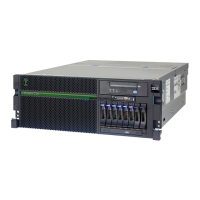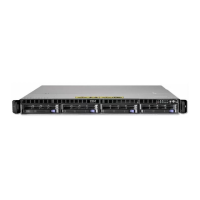170 IBM Power 720 and 740 Technical Overview and Introduction
4.3.5 Locating and servicing
The final component of a comprehensive design for serviceability is the ability to effectively
locate and replace parts requiring service. POWER processor-based systems use a
combination of visual cues and guided maintenance procedures to ensure that the identified
part is replaced correctly, every time.
Packaging for service
The following service enhancements are included in the physical packaging of the systems to
facilitate service:
Color coding (touch points)
– Terra-cotta-colored touch points indicate that a component (FRU or CRU) can be
concurrently maintained.
– Blue-colored touch points delineate components that are not concurrently maintained
(those that require the system to be turned off for removal or repair).
Tool-less design
Selected IBM systems support tool-less or simple tool designs. These designs require no
tools or require basic tools, such as flathead screw drivers to service the hardware
components.
Positive retention
Positive retention mechanisms help to ensure proper connections between hardware
components, such as from cables to connectors, and between two cards that attach to
each other. Without positive retention, hardware components run the risk of becoming
loose during shipping or installation, preventing a good electrical connection. Positive
retention mechanisms such as latches, levers, thumb-screws, pop Nylatches (U-clips),
and cables are included to help prevent loose connections and aid in installing (seating)
parts correctly. These positive retention items do not require tools.
Light Path
The Light Path LED feature is for low-end systems, including Power Systems through models
720 and 740, that can be repaired by clients. In the Light Path LED implementation, when a
fault condition is detected on the POWER7 or POWER7+ processor-based system, an amber
FRU fault LED is illuminated, which is then rolled up to the system fault LED. The Light Path
system pinpoints the exact part by turning on the amber FRU fault LED that is associated with
the part to be replaced.
The system can clearly identify components for replacement by using specific component
level LEDs, and can also guide the servicer directly to the component by signaling (remaining
on, or
solid) the system fault LED, enclosure fault LED, and the component FRU fault LED.
After the repair, the LEDs shut off automatically when the problem is fixed.
Guiding Light
Midrange and high-end systems, including model 760 and later, are usually repaired by IBM
Support personnel.
In the Light Path LED implementation, the system can clearly identify components for
replacement by using specific component-level LEDs, and can also guide the servicer directly
to the component by signaling (turning on solid) the amber system fault LED, enclosure fault
LED, and the component FRU fault LED. The servicer can also use the identify function to
blink the FRU-level LED. When this function is activated, a roll-up to the blue enclosure locate
